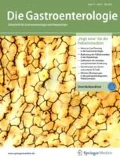Zusammenfassung
Unter den genetischen Hämochromatosen hat nur der autosomal-rezessiv vererbte Typ 1 eine klinische Bedeutung. Hier führt die homozygote Punktmutation C282Y im HFE-Gen zu einer erhöhten intestinalen Eisenresorption und somit im Verlauf von Jahrzehnten zu Eisenablagerung und Schädigung verschiedener Organe (Leber, Pankreas, Herz, Gelenke, Gonaden u. a.). In Populationen keltischer Abstammung ist die Typ-1-Hämochromatose die häufigste vererbte Stoffwechselerkrankung. Die Häufigkeit homozygoter Merkmalsträger liegt bei 0,5%. Aufgrund einer inkompletten Penetranz liegt die Häufigkeit der klinischen Erkrankung nur bei etwa 0,1%. Die Diagnostik der Hämochromatose basiert auf der Bestimmung von Transferrinsättigung und Serumferritin, wobei die Transferrinsättigung sensitiver und spezifischer ist; der Gentest kann die Diagnose sichern. Eine Leberbiopsie wird nur noch bei Ferritinwerten >1000 ng/ml mit der Fragestellung Leberzirrhose empfohlen. Die Aderlasstherapie sichert eine normale Prognose, wenn sie vor dem Auftreten von Leberzirrhose und Diabetes begonnen wird. Zukünftige Anstrengungen müssen deshalb der Früherkennung gelten.
Abstract
Among the conditions known as hereditary hemochromatosis, only the autosomal recessive type 1 has any clinical significance. In this case a homozygote point mutation C282Y in the HFE gene leads to increased intestinal iron resorption and over the course of decades to iron deposition and injury to various organs (e.g. liver, pancreas, heart, joints and gonads). In populations of Celtic descent, type 1 hemochromatosis is the most common hereditary metabolic disease. The frequency of homozygote carriers is approximately 0.5% but because of an incomplete penetrance, the frequency of clinical diseases is only approximately 0.1%. The diagnosis of hemochromatosis is based on determination of transferrin saturation and serum ferritin levels, whereby transferrin saturation is more sensitive and specific. The diagnosis can be confirmed with genetic testing. A liver biopsy is only recommended by ferritin values of >1,000 ng/ml to evaluate the degree of liver fibrosis. Therapeutic phlebotomy ensures a normal prognosis if initiated before the occurrence of liver cirrhosis and diabetes. Therefore future efforts should be dedicated to early recognition.










Literatur
Adams P, Brissot P, Powell LW (2000) EASL International Consensus Conference on Haemochromatosis. J Hepatol 33: 485–504
Adams PC, Reboussin DM, Barton JC et al. (2005) Hemochromatosis and iron-overload screening in a racially diverse population. N Engl J Med 352: 1769–1778
Andrews NC (2005) Understanding heme transport. N Engl J Med 353: 2508–2509
Bacon BR (2001) Hemochromatosis: diagnosis and management. Gastroenterology 120: 718–725
De Domenico I, Diane M, Ward D et al. (2007) Hepcidin regulation: ironing out the details. J Clin Invest 117: 1755–1758
Feder JN, Penny DM, Irrinki A et al. (1998) The hemochromatosis gene product complexes with the transferrin receptor and lowers its affinity for ligand binding. Proc Natl Acad Sci U S A 95: 1472–1477
Gordeuk VR, Caleffi A, Corradini E et al. (2003) Iron overload in Africans and African-Americans and a common mutation in the SCL40A1 (ferroportin 1) gene. Blood Cells Mol Dis 31: 299–304
Goswami T, Andrews NC (2006) Hereditary hemochromatosis protein, HFE, interaction with transferrin receptor 2 suggests a molecular mechanism for mammalian iron sensing. J Biol Chem 281: 28494–28498
Hentze MW, Muckenthaler MU, Andrews NC (2004) Balancing acts: molecular control of mammalian iron metabolism. Cell 117: 285–297
Krishnamurthy P, Ross DD, Nakanishi T et al. (2004) The stem cell marker Bcrp/ABCG2 enhances hypoxic cell survival through interactions with heme. J Biol Chem 279: 24218–24225
Loreal O, Deugnier Y, Moirand R et al. (1992) Liver fibrosis in genetic hemochromatosis. Respective roles of iron and non-iron related factors in 127 homozygous patients. J Hepatol 16: 122–127
Niederau C, Fischer R, Sonnenberg A et al. (1985) Survival and causes of death in cirrhotic and noncirrhotic patients with primary haemochromatosis. N Engl J Med 313: 1256–1262
Niederau C, Fischer R, Pürschel A et al. (1996) Long-term survival in patients with hereditary hemochromatosis. Gastroenterology 110: 1107–1119
Niederau C, Berger M, Stremmel W et al. (1984) Hyperinsulinaemia in non-cirrhotic haemochromatosis: impaired hepatic insulin degradation? Diabetologia 26: 441–444
Niederau C, Niederau CM, Littauer A et al. (1998) Screening for iron overload and iron deficiency. Ann Intern Med 128: 337–345
Nisbet-Brown E, Olivieri NF, Giardina PJ et al. (2003) Effectiveness and safety of ICL670 in iron-loaded patients with thalassaemia: a randomised, double-blind, placebo-controlled, dose-escalation trial. Lancet 361: 1597–1602
Quigley JG, Yang Z, Worthington MT et al. (2004) Identification of a human heme exporter that is essential for erythropoiesis. Cell 118: 757–766
Pietrangelo A (2004) Hereditary hemochromatosis – a new look at an old disease. N Engl J Med 350: 2383–2397
Raffin SB, Woo CH, Roost KT et al. (1974) Intestinal absorption of hemoglobin iron-heme cleavage by mucosal heme oxygenase. J Clin Invest 54: 1344–1352
Shayeghi M, Latunde-Dada GO, Oakhill JS et al. (2005) Identification of an intestinal heme transporter. Cell 122: 789–801
Vulpe CD, Kuo YM, Murphy TL et al. (1999) Hephaestin, a ceruloplasmin homologue implicated in intestinal iron transport, is defective in the sla mouse. Nat Genet 21: 195–199
Interessenkonflikt
Der korrespondierende Autor gibt an, dass kein Interessenkonflikt besteht.
Author information
Authors and Affiliations
Corresponding author
Rights and permissions
About this article
Cite this article
Niederau, C. Genetische Hämochromatose. Gastroenterologe 3, 199–211 (2008). https://doi.org/10.1007/s11377-008-0146-5
Published:
Issue Date:
DOI: https://doi.org/10.1007/s11377-008-0146-5

